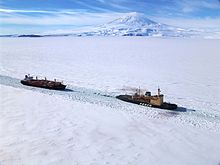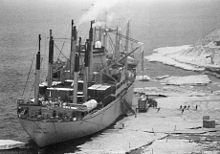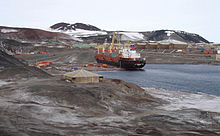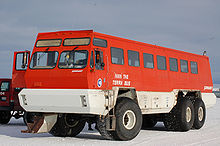- McMurdo Station
-
McMurdo Station is a U.S. Antarctic research center located on the southern tip of Ross Island, which is in the New Zealand-claimed Ross Dependency on the shore of McMurdo Sound in Antarctica. It is operated by the United States through the United States Antarctic Program, a branch of the National Science Foundation. The station is the largest community in Antarctica, capable of supporting up to 1,258 residents,[1] and serves as the United States Antarctic science facility. All personnel and cargo going to or coming from Amundsen-Scott South Pole Station first passes through McMurdo.
Contents
History
The station owes its designation to nearby McMurdo Sound, named after Lieutenant Archibald McMurdo of H.M.S. Terror, which first charted the area in 1841 under the command of British explorer James Clark Ross. British explorer Robert Falcon Scott first established a base close to this spot in 1902 and built Discovery Hut, still standing adjacent to the harbour at Hut Point. The volcanic rock of the site is the southernmost bare ground accessible by ship in the Antarctic. The United States officially opened its first station at McMurdo on Feb. 16, 1956. Founders initially called the station Naval Air Facility McMurdo. On Nov. 28, 1957, Admiral George J. Dufek was present with a U.S. congressional delegation during a change of command ceremony.[2]
McMurdo became the centre of scientific and logistical operation during the International Geophysical Year,[2] an international scientific effort that lasted from July 1, 1957, to Dec. 31, 1958. The Antarctic Treaty, now signed by over forty-five governments, regulates intergovernmental relations with respect to Antarctica and governs the conduct of daily life at McMurdo for United States Antarctic Program (U.S.A.P.) participants. The Antarctic Treaty and related agreements, collectively called the Antarctic Treaty System, A.T.S., was opened for signature on Dec. 1, 1959, and officially entered into force on June 23, 1961.
On March 3, 1962, operators activated a nuclear power plant at the station. The plant, like nearby Scott's Discovery Hut, was prefabricated in modules. Engineers designed the components to weigh no more than 30,000 pounds (13,608 kg) each and to measure no more than 8 ft 8 inches by 8 ft 8 inches by thirty feet. The size restriction allowed, if necessary, shipment by the Hercules LC-130 aircraft via an ice runway at the adjacent Williams Field. A single core no larger than an oil drum served as the heart of the nuclear reactor. Reportedly, the reactor replaced the need for 1,500 US gallons (1,200 imp gal; 5,700 L) of oil daily.[3] Engineers applied the reactor's power, for instance, in producing steam for the salt water distillation plant. The U.S. Army Nuclear Power Program decommissioned the plant in 1972. After the nuclear power station was no longer operational, conventional diesel generators were used. There were a number of 500 kW diesel generators located in a central powerhouse providing electric power. A conventionally fueled water desalination plant provided fresh water.
In 1974 the last LC-130 flight left in late February and did not return for regular service until the ice runway was operational in October. There was a single flight in early September (an LC-130 of VXE-6, Antarctic Development Squadron Six) to bring in US Navy support personnel to prepare the annual sea ice runway and to bring in mail and fresh vegetables. In August 1974, a New Zealand P3 Orion airplane flew to McMurdo and dropped mail via parachute and then returned to New Zealand. During this time, the residents' only contact with the outside world was via the Navy shortwave radio and teletype system, the military MARS radio system, and ham radio, which was connected to stateside ham radio operators' running phone patches.[citation needed]
A 10K-AT "Adverse Terrain" forklift moves a loaded cargo sled as part of Operation Deep Freeze resupply mission
Contemporary function and history
Today, McMurdo Station is Antarctica's largest community and a functional, modern day science station, which includes a harbour, three airfields[4] (two seasonal), a heliport and more than 100 buildings, including the Albert P. Crary Science and Engineering Center. The station is also home to the continent's only ATM, provided by Wells Fargo Bank. The primary focus of the work done at McMurdo Station is science, but most of the residents (approximately 1,000 in the summer and fewer than 200 in the winter) are not scientists, but station personnel who are there to provide support for operations, logistics, information technology, construction, and maintenance.
Scientists and station personnel at McMurdo are participants in the USAP, which co-ordinates research and operational support in the region. Werner Herzog's 2007 documentary Encounters at the End of the World reports on the life and culture of McMurdo Station from the point of view of residents.
 The M/V American Tern being led by the Russian icebreaker Krasin to McMurdo Station during Operation Deep Freeze 2006. Mount Erebus can be seen in the background.
The M/V American Tern being led by the Russian icebreaker Krasin to McMurdo Station during Operation Deep Freeze 2006. Mount Erebus can be seen in the background. The supply ship M/V American Tern during cargo operations at McMurdo Station during Operation Deep Freeze 2007. The square building in the foreground is Discovery Hut.
The supply ship M/V American Tern during cargo operations at McMurdo Station during Operation Deep Freeze 2007. The square building in the foreground is Discovery Hut.
An annual sealift by cargo ships as part of Operation Deep Freeze delivers 8 million US gallons (6.6 million imperial gallons/42 million L) of fuel and 11 million pounds (5 million kg) of supplies and equipment for McMurdo residents.[5] The ships are operated by the U.S. Military Sealift Command and are crewed by civilian mariners. Cargo may range from mail, construction materials, trucks, tractors, dry and frozen food, to scientific instruments. United States Coast Guard icebreakers break a ship channel through ice-clogged McMurdo Sound in order for supply ships to reach Winter Quarters Bay at McMurdo. Additional supplies and personnel are flown in to nearby Williams Field from Christchurch, New Zealand. A variety of fruits and vegetables are grown in a hydroponic green house at the station.
Between 1962 and 1963, 28 Arcas sounding rockets were launched from McMurdo Station.[6]
McMurdo Station is about 2 miles (3 km) from Scott Base, the New Zealand science station, and the entire island is located within a sector claimed by New Zealand, though this claim is not recognized by most countries. Recently there has been criticism leveled at the base regarding its construction projects, particularly the McMurdo-(Amundsen-Scott) South Pole highway.[7]
McMurdo has attempted to improve environmental management and waste removal over the past decade in order to adhere to the Protocol on Environmental Protection to the Antarctic Treaty, which was signed Oct. 4, 1991 and entered into force Jan. 14, 1998. This agreement prevents development and provides for the protection of the Antarctic environment through five specific annexes on marine pollution, fauna, and flora, environmental impact assessments, waste management, and protected areas. It prohibits all activities relating to mineral resources except scientific. A new waste treatment facility was built at McMurdo in 2003, that greatly exceeds the requirements of the treaty. McMurdo (nicknamed "Mac-Town" by its residents) continues to operate as the hub for American activities on the Antarctic continent.
McMurdo Station briefly gained global notice when an anti-war protest was held on Feb. 15, 2003. During the rally, about 50 scientists and station personnel gathered to protest the coming invasion of Iraq by the United States. McMurdo Station was the only Antarctic location to hold such a rally.[8]
Climate
With all months having an average temperature below freezing, McMurdo features a polar ice cap climate (Köppen EF).
Climate data for McMurdo Station Month Jan Feb Mar Apr May Jun Jul Aug Sep Oct Nov Dec Year Average high °C (°F) −0.2
(31.6)−6.3
(20.7)−14
(7)−17.4
(0.7)−19
(−2.2)−19.1
(−2.4)−21.7
(−7.1)−22.8
(−9.0)−20.8
(−5.4)−15.5
(4.1)−6.7
(19.9)−0.8
(30.6)−13.5 Daily mean °C (°F) −2.9
(26.8)−9.5
(14.9)−18.2
(−0.8)−20.7
(−5.3)−21.7
(−7.1)−23
(−9.4)−25.7
(−14.3)−26.1
(−15.0)−24.6
(−12.3)−18.9
(−2.0)−9.7
(14.5)−3.4
(25.9)−16.9 Average low °C (°F) −5.5
(22.1)−11.6
(11.1)−21.1
(−6.0)−24.9
(−12.8)−27.1
(−16.8)−27.3
(−17.1)−30.1
(−22.2)−31.8
(−25.2)−29.4
(−20.9)−23.4
(−10.1)−12.7
(9.1)−6
(21.2)−20.6 Precipitation mm (inches) 15.0
(0.591)21.2
(0.835)24.1
(0.949)18.4
(0.724)23.7
(0.933)24.9
(0.98)15.6
(0.614)11.3
(0.445)11.8
(0.465)9.7
(0.382)9.5
(0.374)15.7
(0.618)202.5
(7.972)Source: Cool Antarctica,[9] Communications
McMurdo, for a time, had Antarctica's only television station, AFAN-TV, running vintage programs provided by the military. The station's equipment was susceptible to "electronic burping" from the diesel generators that provide electricity in the outpost. The station was profiled in a 1974 article in TV Guide magazine. Now, McMurdo receives three channels of the US Military's American Forces Network[citation needed], the Australia Network, and New Zealand news broadcasts. Television broadcasts are received by satellite at Black Island, and transmitted 25 miles (40 km) by digital microwave to McMurdo.
McMurdo Station receives both Internet and voice communications by satellite communications with NASA's TDRS satellite system. A satellite dish at Black Island provides 20Mbit/s Internet connectivity and voice communications. Voice communications are tied into the Raytheon Polar Services Company's headquarters in Centennial, Colorado, providing inbound and outbound calls to McMurdo from the US.
Transportation
McMurdo is serviced seasonally by three airports:
- Pegasus Ice Runway (ICAO: NZPG), a permanent (Blue) ice runway near Black Island.
- Sea Ice Runway (ICAO: NZIR), an annual runway constructed on the sea ice nearest McMurdo Station.
- William’s Field (ICAO: NZWD), a permanent snow runway.
A multitude of on- and off-road vehicles transport people and cargo around the area, including Ivan the Terra Bus.
Points of interest
Facilities worthy of note at the station include:
- Albert P. Crary Science and Engineering Center (CSEC)
- Chapel of the Snows Interfaith Chapel.
- Observation Hill
- Discovery Hut, built during Scott's 1901-1903 expedition.
- Williams Field airport
- Memorial plaque to three airmen killed in 1946 while surveying the territory.
In popular culture
Literature
- McMurdo Station is mentioned in detail in the novel Decipher dealing with an ancient code left by the Atlantians to save the world.
- The First Hundred colonists participated in training and screening at McMurdo Station before heading to Mars in Kim Stanley Robinson's Mars Trilogy.
- Much of Kim Stanley Robinson's science fiction novel Antarctica takes place at McMurdo Station.
- In Matthew Reilly's novel Ice Station, McMurdo Ice Station is mentioned throughout the storyline.
- Carrie Stetko, the main character of the comic book Whiteout (created by Greg Rucka and Steve Lieber), works as a U.S. Marshal at McMurdo Station.
- A portion of David Graham's post-apocalyptic novel Down to a Sunless Sea takes place at McMurdo Station.
- McMurdo is very briefly mentioned in the denouement of Tom Clancy's book The Hunt For Red October as a possible 'punishment tour' for anyone caught talking about the events that make up the story.
- In Cold Pursuit, a mystery by Sarah Andrews, is based in McMurdo Station.
- In Antarctic Navigation by Elizabeth Arthur, the novel's main character first works at McMurdo Station at a menial job, then later returns there in a very different role, leading a polar expedition to retrace the steps of Robert Scott. The author herself spent time in the station under a grant from the Antarctic Artists and Writers Foundation.
- In William Brinkley's post-nuclear apocalypse novel, The Last Ship, McMurdo Station becomes the essential restocking point for an American-Russian submarine crew of survivors.
- In James Rollins' adventure-thriller novel "Subterranean", McMurdo Station is the resting/resupplying point of the archaeology team before they head to, and into Mount Erebus.
Film
- McMurdo Station is referred to in the science fiction movies Dark Star and Alien as being the site of a major space-traffic control center.
- McMurdo Station is mentioned in John Carpenter's The Thing and in the American adventure film Eight Below.
- In Stargate SG-1 McMurdo is mentioned as a staging area for Earth's squadrons of F-302 fighters. Also in the same series, 50 miles (80 km) from the station is the location of Earth's second Stargate, left over from an ancient site that was once the location of Atlantis. John Sheppard of Stargate Atlantis was transferred here after disobeying orders in Afghanistan, and the base is also mentioned in the movie Stargate: Continuum.
- Werner Herzog's 2007 documentary, Encounters at the End of the World, deals almost exclusively with individuals living at the McMurdo research station.
- Anne Aghion's 2009 documentary, Ice People, is an exploration of Antarctica with scientists Allan Ashworth and Adam Lewis researching the discovery of 13.9 million-year-old moss fossils and the proof of climate change with the help of the McMurdo Station Staff.
See also
References
- ^ 4.0 Antarctica - Past and Present
- ^ a b "US Antarctic Base Has Busy Day". Google News Archive. Spartanburg Herald-Journal. November 29, 1957. http://news.google.com/newspapers?id=tGksAAAAIBAJ&sjid=bMsEAAAAIBAJ&pg=7323,4149121&dq=antarctic+base&hl=en. Retrieved 7 July 2010.
- ^ Clarke, Peter McFerrin (1966). On the ice. Burdette.
- ^ Miguel Llanos (2007-01-25). "Reflections from time on 'the Ice'". MSNBC. http://www.msnbc.msn.com/id/15834019/. Retrieved 2008-01-11.
- ^ Modern Marvels: Sub-Zero. The History Channel.
- ^ [1]
- ^ Moss, Stephen (January 24, 2003). "No, not a ski resort - it's the south pole". The Guardian (London). http://www.guardian.co.uk/g2/story/0,3604,881101,00.html. Retrieved May 12, 2010.
- ^ Protest photos accessed on 29th August 2010
- ^ "Antarctica Climate data and graphs, South Pole, McMurdo and Vostok". http://www.coolantarctica.com/Antarctica%20fact%20file/antarctica%20environment/climate_graph/vostok_south_pole_mcmurdo.htm.
- United States Antarctic Research Program Calendar 1983
- "Facts About the United States Antarctic Research Program." Division of Polar Programs, National Science Foundation; July 1982.
- Clarke, Peter; On the Ice. Rand McNally & Company, 1966
External links
- McMurdo Station on Google Maps
- "McMurdo Station". Geographic Names Information System, U.S. Geological Survey. http://geonames.usgs.gov/pls/gnispublic/f?p=gnispq:5:::NO::P5_ANTAR_ID:19095.
- National Science Foundation page about McMurdo Station
- Virtual Tour - McMurdo Station Antarctica
- Life and work at McMurdo Station - from USA Today
- Information (including flight records) about NASA's balloon launches at Williams Field
- McMurdo Station weather data
- Big Dead Place (life, culture, and satire of Antarctic residency)
- Usap McMurdo Station webcam
- COMNAP Antarctic Facilities
- COMNAP Antarctic Facilities Map
- High resolution GigaPan picture of McMurdo station
Antarctica Main articles - Antarctic
- History
- Geography
- Climate
- Expeditions
- Research stations
- Field camps
- Territorial claims
- Antarctic Treaty System
- Telecommunications
- Demographics
- Economy
- Tourism
- Transport
- Military activity in the Antarctic
Geographic regions - Antarctic Peninsula
- East Antarctica
- West Antarctica
- Extreme points of the Antarctic
- List of Antarctic and subantarctic islands
- Antarctica ecozone
Waterways Famous explorers Research stations of Antarctica Year-round Argentina- Belgrano II
- Esperanza
- Jubany
- Marambio
- Orcadas
- San Martín
Europe- Princess Elisabeth (Belgium)
- Concordia / Dumont d'Urville (France)
- Concordia / Mario Zucchelli (Italy)
- Neumayer III (Germany)
- Troll (Norway)
- Arctowski (Poland)
- Halley / Rothera (UK)
- Vernadsky (Ukraine)
Russia- Amundsen-Scott
- McMurdo
- Palmer
Others- Comandante Ferraz (Brazil)
- Great Wall / Zhongshan (PR China)
- Maitri (India)
- Dome Fuji / Showa (Japan)
- King Sejong (South Korea)
- Scott (New Zealand)
- SANAE IV (South Africa)
- Artigas (Uruguay)
Summer - Almirante Brown / Cámara / Decepción / Matienzo / Petrel (Argentina)
- St. Kliment Ohridski (Bulgaria)
- Carvajal / González Videla / Risopatrón (Chile)
- Kunlun (China)
- Mendel (Czech Republic)
- Maldonado (Ecuador)
- Aboa (Finland)
- Kohnen (Germany)
- Zucchelli (Italy)
- Dome Fuji (Japan)
- Tor (Norway)
- Jinnah (Pakistan)
- Machu Picchu (Peru)
- Law-Racoviţă (Romania)
- Gabriel de Castilla / Juan Carlos I (Spain)
- Svea / Wasa (Sweden)
- Signy (UK)
- Byrd (United States)
- Elichiribehety (Uruguay)
Closed - Dakshin Gangotri (India)
- Asuka / Mizuho (Japan)
- Hallett / Vanda (New Zealand)
- Komsomolskaya / Leningradskaya / Molodyozhnaya / Russkaya (Soviet Union)
- Ellsworth (USA / Argentina)
- World Park Base (Greenpeace)
Categories:- Outposts of Antarctica
- McMurdo Station
- Buildings and structures in Antarctica
- Outposts of the Ross Dependency
Wikimedia Foundation. 2010.







